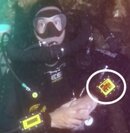Poseidon and Ouroboros both have buddy lights on the back of the unit as well. One on the HUD does nothing unless you're in sight of it. So if the point is to be able to recognize an unsafe loop condition that your buddy is unaware of, only making it available for one orientation is limiting. Now I've only been diving with a few JJ guys, but I have yet to see a buddy light on any of them, HUD or otherwise. It's entirely possible that their HUD's are different than yours. I'm not down with all of the JJ revisions over the years. DiveCAN vs others maybe? Or is it because it's only on in an emergency? I would never know. Anyway, rarely are we facing each other, so if seeing their HUD area is the only way to see an indication, it's only worthwhile in a few limited scenarios.
It needs to have some sort of "I'm working" indicator. If there's nothing, you don't know if it's working or not. If it only goes off if it alarms, you're never sure if it's working until you reach that alarm state, in which case, what's the point? Let's say it fails, your buddy is breathing an unsafe loop and you are none the wiser. The thing with the PO2 display on the HUD, you always have confirmation that it is functioning. It is ALWAYS giving data. A buddy light that doesn't give you confirmation is like the thermostat in the liquid O2 tank on the Apollo 13. When it fused shut and the tank got to over 1000 degrees, the temperature still said 25. Because that's as far as the readout went. Turns out 25 is where it was supposed to shut off. If the alarm state is the only way to know it's functioning, you'll never know if it's working until it's an emergency. Why should a HUD display anything then unless it's dangerous way above or way below setpoint? HUD's exist solely because they give us constant data. If they didn't, there would be no point. If you want your buddy to know the state of your loop, they need some sort of data. In this case, the absence of data isn't data enough in my mind. And it is a positive indicator of failure. You want something to tell you when something isn't working, you don't want to just find out when it doesn't do what it's supposed to do. Hell, even cells tell you this theoretically, mV either dirt dives or skyrockets. Not always, but often enough.
The Meg 2.7 handset (the APECS controller, not the Predator) actually has a little spinning cursor so that you know the unit is actually working. Otherwise you look at it and it will say your setpoint is whatever all day long. Apparently it was determined that the risk of frozen electronics was enough to include it.
As for the handset alarming, I'm not talking about blanking out the screen so that it's useless. I'm talking about making the alarm condition effing obnoxious until you deal with it. A giant square of flashing red is much more apparent than a single red LED blinking, or just the PO2 row. And there's nothing that says it has to stay this way, only that it will until you do SOMETHING. Whether that's switching to bailout on the computer, driving the PO2 below 1.6, whatever. An impaired diver might not immediately react to minimal red flashing, but something big and apparent trips that lizard brain like no other. Right now the PO2 readings just flash red. If you look at the video, you can see that it's only the PO2 row of his controller that's flashing red for danger. I guarantee his HUD was as well.

He's lucky his buddy was attentive. If the whole screen was flashing red, it would be much more apparent to everybody. I certainly notice being able to see my buddies Shearwaters much more often than you would imagine. And you don't have to be able to interpret the data the computer is displaying, you just have to recognize it's in angry mode. Actual bright flashy things get your attention, even if you don't have direct viewing angle to it. Aside from the fact that you'd really have to be pretty dark to see the LED (the Meg HUD's are rough even with it pointing straight at you on the other side of your mask), and you'd never see it if you've got your light illuminating your buddy at all, ultimately it needs to be unobtrusive enough that it's not a distraction, heck, even if it takes you a second to look for it, but actually gets your attention when it needs to. "No way to tell if it's working" is a bit too unobtrusive. The Hammerhead "buddy light" is too obtrusive.....
It's not that I disagree that putting a little LED on the NERD is a bad idea, I just think that it's ineffective the way you describe it, so what's the point? If you're going to use some system to alert your buddy, don't half @$$ it, whole @$$ that thing so there's no way your buddy can miss it. Make it like a damn xenon strobe. Make it a Cree XHP 70. Make the sucker impossible to ignore. Do the DIVA thing and vibrate the hell out of the mouth piece with a motor loud enough that your buddies can hear it.
Aside from the difficulty in implementing the architecture, wireless buddy state is probably the best way to ultimately go about it. If your buddy is alert, they're definitely gonna notice their computer saying something is wrong. And if it's the, "your buddy is gonna die" alert, they're gonna notice it right away.




